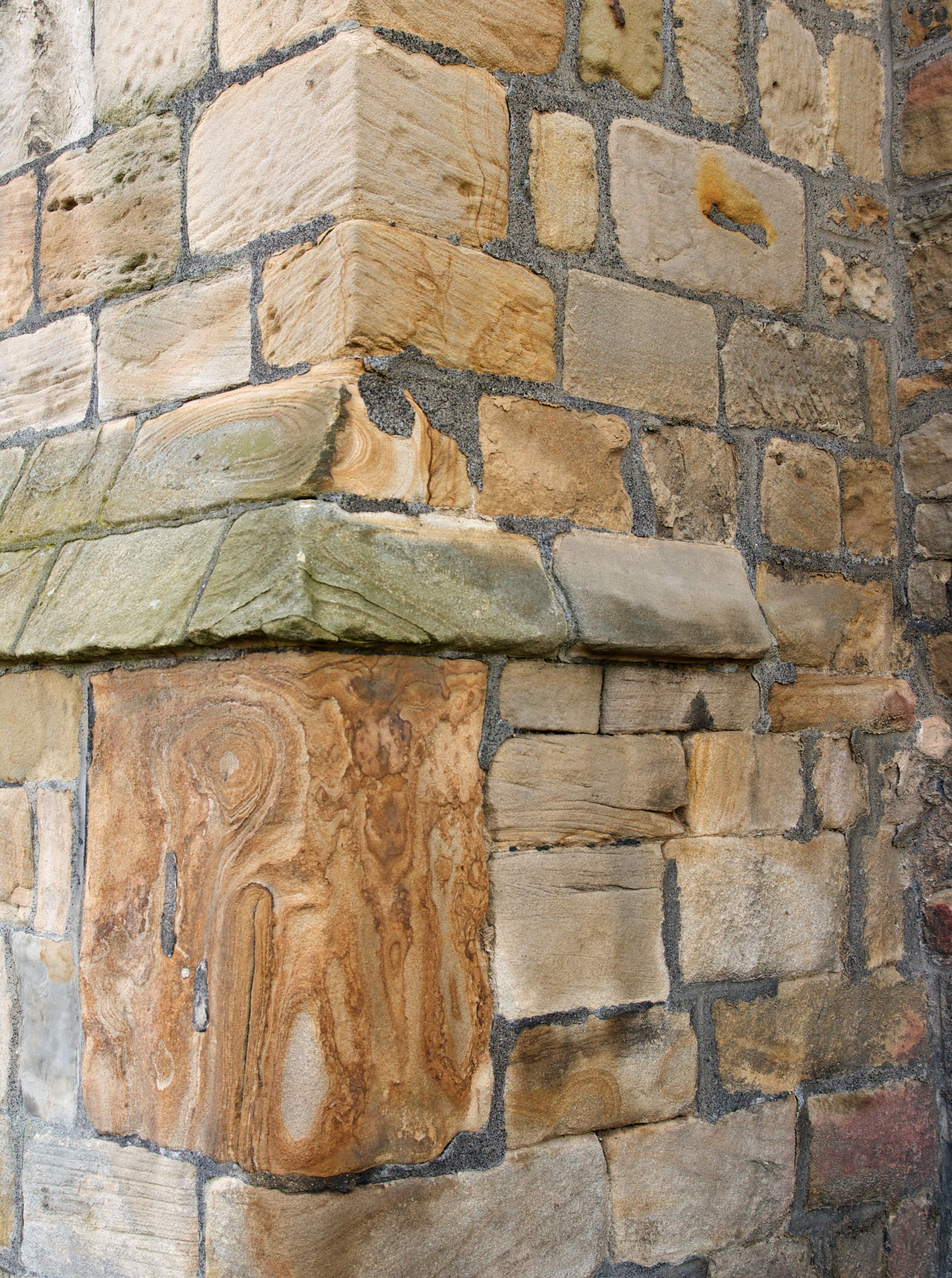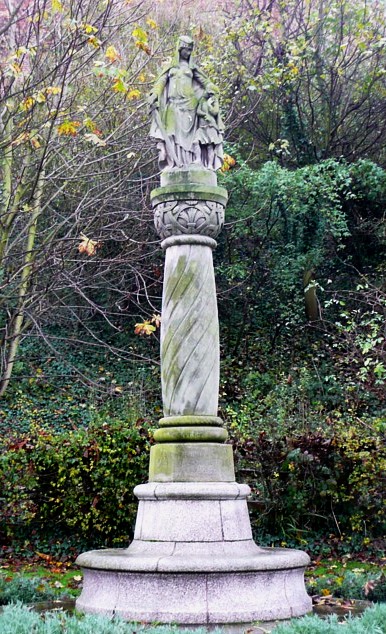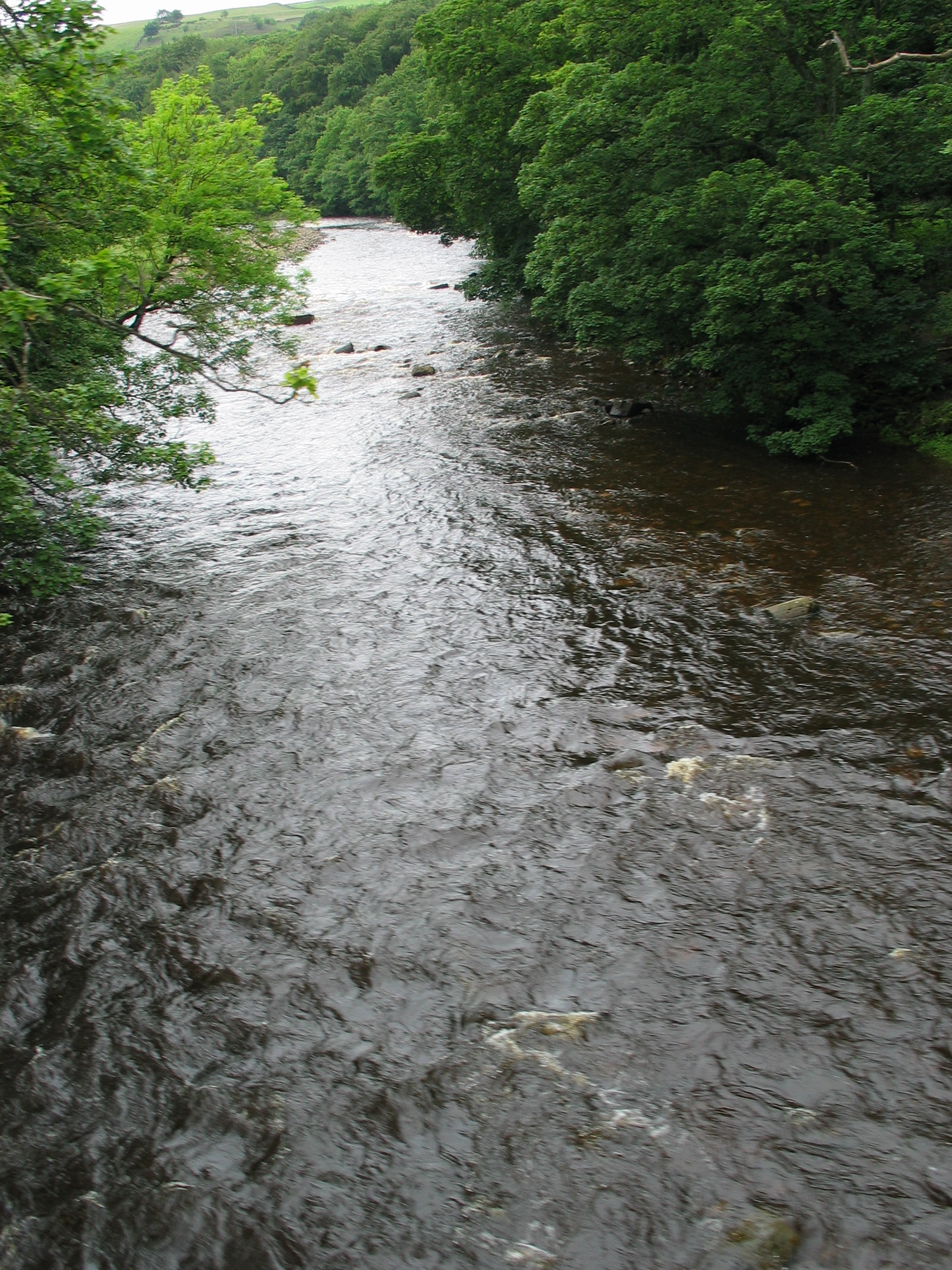|
St Mary And St Cuthbert, Chester-le-Street
The parish church of St Mary and St Cuthbert is a Church of England church in Chester-le-Street, County Durham, England. The site has been used for worship for over 1100 years; elements of the current building are over 950 years old. The oldest surviving translation of the Gospels into English was done here, by Aldred between 947 and 968, at a time when it served as the centre of Christianity from Lothian to Teesside. St Cuthbert's community The church was established to house the body of Cuthbert of Lindisfarne, Bishop of Lindisfarne from 684 to 687. After his death he became one of the most venerated saints of the time, with a significant cultus and the Venerable Bede writing both a verse and prose biography of him. So when driven out of Lindisfarne by Viking raids in 875 the monks took St Cuthbert's coffin along with other valuable items. They wandered for seven years before eventually settling at Chester-le-Street (then called Cunecaster or Conceastre), at the site of the ol ... [...More Info...] [...Related Items...] OR: [Wikipedia] [Google] [Baidu] |
County Durham
County Durham ( ), officially simply Durham,UK General Acts 1997 c. 23Lieutenancies Act 1997 Schedule 1(3). From legislation.gov.uk, retrieved 6 April 2022. is a ceremonial county in North East England.North East Assembly ÔÇAbout North East England. Retrieved 30 November 2007. The ceremonial county spawned from the historic County Palatine of Durham in 1853. In 1996, the county gained part of the abolished ceremonial county of Cleveland.Lieutenancies Act 1997 . Retrieved 27 October 2014. The is the of [...More Info...] [...Related Items...] OR: [Wikipedia] [Google] [Baidu] |
Viking
Vikings ; non, v├şkingr is the modern name given to seafaring people originally from Scandinavia (present-day Denmark, Norway and Sweden), who from the late 8th to the late 11th centuries raided, pirated, traded and settled throughout parts of Europe.Roesdahl, pp. 9ÔÇô22. They also voyaged as far as the Mediterranean, North Africa, Volga Bulgaria, the Middle East, and North America. In some of the countries they raided and settled in, this period is popularly known as the Viking Age, and the term "Viking" also commonly includes the inhabitants of the Scandinavian homelands as a collective whole. The Vikings had a profound impact on the early medieval history of Scandinavia, the British Isles, France, Estonia, and Kievan Rus'. Expert sailors and navigators aboard their characteristic longships, Vikings established Norse settlements and governments in the British Isles, the Faroe Islands, Iceland, Greenland, Normandy, and the Baltic coast, as well as ... [...More Info...] [...Related Items...] OR: [Wikipedia] [Google] [Baidu] |
├ćthelstan
├ćthelstan or Athelstan (; ang, ├ć├░elst─ün ; on, A├░alsteinn; ; ÔÇô 27 October 939) was List of monarchs of Wessex, King of the Anglo-Saxons from 924 to 927 and List of English monarchs, King of the English from 927 to his death in 939. He was the son of King Edward the Elder and his first wife, Ecgwynn. Modern historians regard him as the first King of England and one of the "greatest Anglo-Saxon kings". He never married and had no children; he was succeeded by his half-brother, Edmund I. When Edward died in July 924, ├ćthelstan was accepted by the Mercians as king. His half-brother ├ćlfweard of Wessex, ├ćlfweard may have been recognised as king in Wessex, but died within three weeks of their father's death. ├ćthelstan encountered resistance in Wessex for several months, and was not crowned until September 925. In 927 he conquered the last remaining Viking kingdom, Scandinavian York, York, making him the first Anglo-Saxon ruler of the whole of England. In 934 he invaded ... [...More Info...] [...Related Items...] OR: [Wikipedia] [Google] [Baidu] |
Alfred The Great
Alfred the Great (alt. ├ćlfred 848/849 ÔÇô 26 October 899) was King of the West Saxons from 871 to 886, and King of the Anglo-Saxons from 886 until his death in 899. He was the youngest son of King ├ćthelwulf and his first wife Osburh, who both died when Alfred was young. Three of Alfred's brothers, ├ćthelbald, ├ćthelberht and ├ćthelred, reigned in turn before him. Under Alfred's rule, considerable administrative and military reforms were introduced, prompting lasting change in England. After ascending the throne, Alfred spent several years fighting Viking invasions. He won a decisive victory in the Battle of Edington in 878 and made an agreement with the Vikings, dividing England between Anglo-Saxon territory and the Viking-ruled Danelaw, composed of northern England, the north-east Midlands and East Anglia. Alfred also oversaw the conversion of Viking leader Guthrum to Christianity. He defended his kingdom against the Viking attempt at conquest, becoming the dominan ... [...More Info...] [...Related Items...] OR: [Wikipedia] [Google] [Baidu] |
Irish Sea
The Irish Sea or , gv, Y Keayn Yernagh, sco, Erse Sie, gd, Muir ├łireann , Ulster-Scots: ''Airish Sea'', cy, M├┤r Iwerddon . is an extensive body of water that separates the islands of Ireland and Great Britain. It is linked to the Celtic Sea in the south by St George's Channel and to the Inner Seas off the West Coast of Scotland in the north by the North Channel. Anglesey, North Wales, is the largest island in the Irish Sea, followed by the Isle of Man. The term ''Manx Sea'' may occasionally be encountered ( cy, M├┤r Manaw, ga, Muir Meann gv, Mooir Vannin, gd, Muir Mhanainn). On its shoreline are Scotland to the north, England to the east, Wales to the southeast, Northern Ireland and the Republic of Ireland to the west. The Irish Sea is of significant economic importance to regional trade, shipping and transport, as well as fishing and power generation in the form of wind power and nuclear power plants. Annual traffic between Great Britain and Ireland a ... [...More Info...] [...Related Items...] OR: [Wikipedia] [Google] [Baidu] |
Kingdom Of Alba
The Kingdom of Alba ( la, Scotia; sga, Alba) was the Kingdom of Scotland between the deaths of Donald II in 900 and of Alexander III in 1286. The latter's death led indirectly to an invasion of Scotland by Edward I of England in 1296 and the First War of Scottish Independence. Alba included Dalriada, but not large parts of the present day Scottish Lowlands, which were then divided between Strathclyde and Northumbria as far north as the Firth of Forth. Fortriu, a Pictish kingdom in the north, was added to Alba in the tenth century. Until the early 13th century, Moray was not considered part of Alba, which was seen as extending only between the Firth of Forth and the River Spey. The name of Alba is one of convenience, as throughout this period both the ruling and lower classes of the Kingdom were predominantly Pictish-Gaels, later Pictish-Gaels and Scoto-Normans. This differs markedly from the period of the House of Stuart, beginning in 1371, in which the ruling classes o ... [...More Info...] [...Related Items...] OR: [Wikipedia] [Google] [Baidu] |
Danelaw
The Danelaw (, also known as the Danelagh; ang, Dena lagu; da, Danelagen) was the part of England in which the laws of the Danes held sway and dominated those of the Anglo-Saxons. The Danelaw contrasts with the West Saxon law and the Mercian law. The term is first recorded in the early 11th century as ''Dena lage''. The areas that constituted the Danelaw lie in northern and eastern England, long occupied by Danes and other Norsemen. The Danelaw originated from the invasion of the Great Heathen Army into England in the 9th century, although the term was not used to describe a geographic area until the 11th century. With the increase in population and productivity in Scandinavia, Viking warriors, having sought treasure and glory in the nearby British Isles, "proceeded to plough and support themselves", in the words of the '' Anglo-Saxon Chronicle'' for the year 876. Danelaw can describe the set of legal terms and definitions created in the treaties between Alfred the Grea ... [...More Info...] [...Related Items...] OR: [Wikipedia] [Google] [Baidu] |
Cuncacestre
Cuncacestre ( Chester-le-Street) was a seat of the Anglo Saxon Bishop of Lindisfarne, and subsists as a Roman Catholic titular see. Start of the Diocese The church was established to house the body of Cuthbert of Lindisfarne, Bishop of Lindisfarne from 684 to 687. After his death he became one of the most venerated saints of the time, with a significant cultus and the Venerable Bede writing both a verse and prose biography of him. So when driven out of Lindisfarne by Viking raids in 875 the monks, led by Eardulf of Lindisfarne, took St Cuthbert's coffin along with other valuable items, including the Lindisfarne Gospels. They wandered for seven years. They eventually settled at Chester-le-Street (then called Cunecaster or Conceastre), at the site of the old Roman fort of Concangis, in 883, on land granted to them by Guthred. They built a wooden church and shrine for St Cuthbert's relics, dedicating it to St Mary and St Cuthbert. Though there was no shortage of stone in t ... [...More Info...] [...Related Items...] OR: [Wikipedia] [Google] [Baidu] |
Diocese
In church governance, a diocese or bishopric is the ecclesiastical district under the jurisdiction of a bishop. History In the later organization of the Roman Empire, the increasingly subdivided provinces were administratively associated in a larger unit, the diocese ( Latin ''dioecesis'', from the Greek term ╬┤╬╣╬┐╬»╬║╬̤â╬╣¤é, meaning "administration"). Christianity was given legal status in 313 with the Edict of Milan. Churches began to organize themselves into dioceses based on the civil dioceses, not on the larger regional imperial districts. These dioceses were often smaller than the provinces. Christianity was declared the Empire's official religion by Theodosius I in 380. Constantine I in 318 gave litigants the right to have court cases transferred from the civil courts to the bishops. This situation must have hardly survived Julian, 361ÔÇô363. Episcopal courts are not heard of again in the East until 398 and in the West in 408. The quality of these court ... [...More Info...] [...Related Items...] OR: [Wikipedia] [Google] [Baidu] |
Cathedral
A cathedral is a church that contains the ''cathedra'' () of a bishop, thus serving as the central church of a diocese, conference, or episcopate. Churches with the function of "cathedral" are usually specific to those Christian denominations with an episcopal hierarchy, such as the Catholic, Eastern Orthodox, Anglican, and some Lutheran churches.New Standard Encyclopedia, 1998 by Standard Educational Corporation, Chicago, Illinois; page B-262c Church buildings embodying the functions of a cathedral first appeared in Italy, Gaul, Spain, and North Africa in the 4th century, but cathedrals did not become universal within the Western Catholic Church until the 12th century, by which time they had developed architectural forms, institutional structures, and legal identities distinct from parish churches, monastic churches, and episcopal residences. The cathedral is more important in the hierarchy than the church because it is from the cathedral that the bishop governs the ... [...More Info...] [...Related Items...] OR: [Wikipedia] [Google] [Baidu] |
River Wear
The River Wear (, ) in North East England rises in the Pennines and flows eastwards, mostly through County Durham to the North Sea in the City of Sunderland. At long, it is one of the region's longest rivers, wends in a steep valley through the cathedral city of Durham and gives its name to Weardale in its upper reach and Wearside by its mouth. Etymology The origin behind the hydronym ''Wear'' is uncertain but is generally understood to be Celtic. The ''River Vedra'' on the Roman Map of Britain may very well be the River Wear. The name may be derived from Brittonic ''*wejr'' (<''*wẹ:drā''), which meant "a bend" (c.f ''-gwair-''). An alternative but very problematic etymology might involve ''*wẹ:d-r-'', from a lengthened form of the |
Cade's Road
Cade's Road is a Roman Road in north-east England. It is named after John Cade of Durham, an 18th-century antiquarian who in 1785 proposed its existence and possible course from the Humber Estuary northwards to the River Tyne, a distance of about . The road's Roman name is unknown. Although evidence exists for such a road on some parts of the proposed route, there is still some doubt regarding its exact course. * * Examples of place names with the suffix "le-Street" : * Chester-le-Street, County Durham ( Concangis Roman fort ) MAGiC MaP : Table of Contents * Designations * -- Listed Buildings (COLOURED SQUARE) * -- Scheduled Monuments (SHADED POLYGON) COLOUR MAPPING * OS Colour Mapping * Thornton-le-Street, near Thirsk, North Yorkshire MAGiC MaP : Table of Contents * Administrative * -- Parish Boundary (PURPLE LINE) COLOUR MAPPING * OS Colour Mapping * Thorpe le Street, near Pocklington, East Riding of Yorkshire Route From the Humber to the Tees ... [...More Info...] [...Related Items...] OR: [Wikipedia] [Google] [Baidu] |








